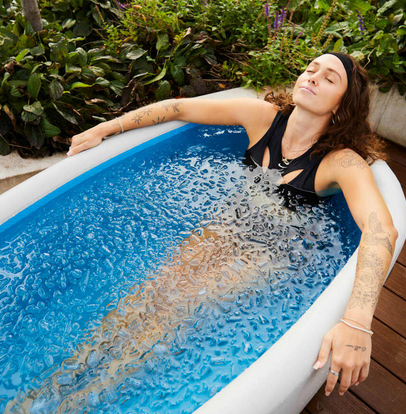Cold water therapy, also known as cold immersion or cold plunge therapy, has gained significant attention in the fitness community for its numerous health benefits. From reducing muscle soreness to boosting recovery, cold water immersion can be an excellent addition to your fitness regimen. If you’re considering incorporating this invigorating practice into your routine, here are some tips and tricks to help you get started effectively.
1. Understand the Benefits of Cold Water Therapy
Recovery and Muscle Soreness
Cold water therapy helps reduce inflammation and muscle soreness after strenuous workouts. The cold constricts blood vessels, limiting swelling and tissue breakdown.
Enhanced Circulation
Once you leave the cold water, your blood vessels dilate, improving circulation. This process helps deliver essential nutrients to muscles, promoting recovery.
Mental Clarity and Mood Boost
Exposure to cold water can stimulate the release of endorphins, leading to improved mood and mental clarity. It can also help reduce stress levels, making it a great addition to your overall wellness routine.
2. Choose the Right Setting
Home vs. Professional Facilities
You can practice cold water therapy at home using your bathtub, a cold shower, or a dedicated cold plunge tub. Alternatively, many fitness centers and wellness spas offer cold plunge facilities.
Temperature Considerations
Aim for a water temperature between 50°F and 59°F (10°C to 15°C) for optimal benefits. If you’re new to cold immersion, start at the higher end and gradually decrease the temperature as you become more accustomed.
3. Start Slow
Gradual Exposure
If you’re new to cold water therapy, begin with shorter exposure times. Start with just 30 seconds to 1 minute and gradually increase the duration as your body acclimates.
Listen to Your Body
Pay attention to how your body responds. If you feel excessively uncomfortable or experience pain, it’s important to exit the cold water and try again later.
4. Incorporate Cold Water Therapy into Your Routine
Post-Workout Sessions
The best time to use cold water therapy is immediately after a workout. This timing allows for effective muscle recovery and helps reduce soreness.
Frequency
Consider incorporating cold water therapy 1-3 times per week, depending on your fitness level and the intensity of your workouts. Adjust the frequency based on your recovery needs.
5. Use Breathing Techniques
Controlled Breathing
Practice deep, controlled breathing while in the cold water. This technique can help you manage the shock of the cold and enhance relaxation.
Benefits of Breathwork
Focusing on your breath can reduce anxiety and improve your overall experience in the cold water. Techniques like the Wim Hof Method emphasize breathing exercises that can enhance your tolerance to cold exposure.
6. Combine with Other Recovery Techniques
Contrast Therapy
Consider alternating between hot and cold therapies for enhanced recovery. This technique, known as contrast therapy, involves switching between a hot shower or bath and cold water immersion.
Stretching and Mobility Work
Incorporate stretching or mobility work after your cold water session. This combination can enhance flexibility and promote further recovery.
7. Stay Hydrated and Nourished
Importance of Hydration
Cold water immersion can lead to increased metabolism and fluid loss. Ensure you drink plenty of water before and after your session to stay hydrated.
Nutritional Considerations
Fuel your body with nutrient-dense foods that support recovery. Focus on consuming proteins, healthy fats, and carbohydrates to replenish energy stores.
8. Create a Routine
Set a Schedule
Designate specific days and times for your cold water therapy sessions. Consistency is key to reaping the full benefits.
Track Your Progress
Keep a journal to track your sessions, noting how you feel before and after. This practice can help you identify patterns and make adjustments as needed.
9. Find a Support System
Buddy System
Consider inviting a friend or workout partner to join you in cold water therapy. Having a buddy can make the experience more enjoyable and encourage accountability.
Online Communities
Join online forums or social media groups focused on cold water therapy and recovery. Sharing experiences and tips with others can enhance your knowledge and motivation.
10. Prepare for the Experience
Mental Preparation
Before entering the cold water, take a moment to mentally prepare yourself. Visualize a positive experience and remind yourself of the benefits you’re seeking.
Warm-Up Routine
Consider doing a light warm-up before your cold exposure. A quick workout or mobility exercises can increase blood flow and make the transition to cold water more manageable.
Conclusion
Incorporating cold water therapy into your fitness routine can provide numerous benefits, from enhanced recovery to improved mental clarity. By understanding the advantages, choosing the right setting, and gradually acclimating your body, you can make the most of this invigorating practice. Combine it with other recovery techniques and maintain consistency to experience the full spectrum of benefits. As you embark on this journey, remember to listen to your body, stay hydrated, and seek support from others. With dedication and mindfulness, cold water therapy can become a valuable addition to your overall wellness and fitness regimen. Embrace the chill and enjoy the refreshing rewards it brings!





Comments